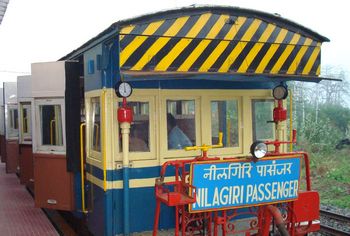Mountain Railways of India
13 Oct 08, 08:29pm

13 Oct 08, 08:29pm

On October 15, 2008, the Coonoor â Udhagamandalam metre gauge mountain railway line completes 100 years. The 18 km long Coonoor â Udhagamandalam section is a part of the Nilgiri Mountain Railway â Asia's steepest and longest metre gauge mountain railway. As we salute this technological wonder that has carried passengers, over some of the most beautiful hill terrain for the last century, let us also look at the history of this mountain railway which is now a heritage symbol.
Though several proposals were mooted since 1854 for the construction of a rail line from the foothills of Nilgiris at Mettupalayam to the Udagamandalam peak, it took over three long decades for the Mountain Railway to become a reality. With the opening of the branch line between Podanur and Mettupalayam by the Madras Railway Company in 1873, Mettupalayam became the foothill point for anybody going to the hills.
Proposals for the mountain railway line became more feasible now, and in 1882, the Swiss inventor, M. Riggenbach's proposal for construction of the Nilgiri Mountain Railway on the 'Rigi pattern' found acceptance. The "Nilgiri Rigi Railway Company Ltd." was formed in 1885 with a capital of Rs.25 lakhs with the mandate to undertake the construction of the Mettupalayam â Coonoor Railway Line. Work on this line was inaugurated by Lord Wenlock the then Governor of Madras Presidency, in August 1891. The Mettupalayam â Coonoor section was thrown open to public traffic on June 15, 1899 but it was extended upto Udhagamandalam only in 1908 after the ownership shifted to the Indian Government in January 1903. The Coonoor â Fernhill section was opened on 15.09.1908 and the Coonoor â Ooty section was opened on 15.10.1908. The extension of the line from Coonoor to Ootacamund cost Rs. 24.4 lakhs and took 60 months for construction.
The system of operation on this Heritage Railway line is the Absolute Block System where the block instruments are of the "Neals tablet type", an instrument which is rarely seen in other sections. The Hill Railways also has lower quadrant semaphore signals. The loco shed in Coonoor is the only functioning steam loco shed on Southern Railway and came into existence in 1899. Twelve X-class steam locomotives have been procured fromSwitzerland and are maintained in this shed for operation on the Mettupalayam â Coonoor section.
While 'X' class steam locomotives push up the toy train on the steep incline between Mettupalayam and Coonoor, traction changes to diesel locomotives from Coonoor on the section between Coonoor and Udhagamandalam. While the ruling gradient (the steepest grade in the section) on Mettupalayam â Coonoor section is 1 in 12.28 which is the steepest gradient in Asia, it is only 1 in 23 on the Coonoor â Udhagamandalam section and hence does not need the rack and pinion or the Alternate Biting System available between Kallar and Coonoor. With regard to the 18 km long Coonoor â Udhagamandalam section, the toy train runs at a speed of 30 kmph and covers the section in 75 minutes.
This metre gauge toy train which is a very popular tourist attraction operates with 4 coaches each of which are 11.516 m in length and 2.15 m wide. The unique feature of these bogies is that each coach is provided with two separate hand brakes, one for adhesion and the other for pinion brakes. A brakesman travels in each coach and applies the hand brake to give additional braking effort which is required as the train traverses over the Mettupalayam â Coonoor section on its rack and pinion arrangement.
The Salem division of Southern Railway runs 4 pairs of trains per day on the Nilgiri Mountain Railway, of which one pair runs between Mettupalayam and Udhagamandalam and 3 pairs of trains are operated between Coonoor and Udhagamandalam. The rising passenger index on the Mountain Railway stands testimony to the popularity of this system. In the last five years, there has been a 44% increase in the number of passengers in the Coonoor â Udhagamandalam section, with a corresponding hike of 18% in earnings. Last year, Coonoor station had an annual earnings of Rs.20,15,884/- and Udhagamandalam station had an annual earnings of Rs.35,06,400/-.
Salient features of the Nilgiri Mountain Railway
WORLD HERITAGE STATUS FOR NILGIRI MOUNTAIN RAILWAY
At the 29th Session of the World Heritage Committee Meeting at Durban on July 15, 2005, the application submitted by the Ministry of Railways, for Inscription of the Nilgiri Mountain Railway as a World Heritage Site, was accepted. The World Heritage Committee of the UNESCO accepted the proposal as an extension of Darjeeling Himalayan Railway in view of the fact that "Mountain Railways of India are outstanding examples of the interchange of values on developments in technology, and the impact of innovative transportation system on the social and economic development of a multicultural region, which was to serve as a model for similar developments in many parts of the world." The Committee also added that "The Mountain Railways of India are outstanding examples of a technological ensemble, representing different phases of the development in high mountain areas."
The Nilgiri Mountain Railway and the Darjeeling Himalayan Railway have been jointly renamed by the World Heritage Committee as the "Mountain Railways of India".
Though several proposals were mooted since 1854 for the construction of a rail line from the foothills of Nilgiris at Mettupalayam to the Udagamandalam peak, it took over three long decades for the Mountain Railway to become a reality. With the opening of the branch line between Podanur and Mettupalayam by the Madras Railway Company in 1873, Mettupalayam became the foothill point for anybody going to the hills.
Proposals for the mountain railway line became more feasible now, and in 1882, the Swiss inventor, M. Riggenbach's proposal for construction of the Nilgiri Mountain Railway on the 'Rigi pattern' found acceptance. The "Nilgiri Rigi Railway Company Ltd." was formed in 1885 with a capital of Rs.25 lakhs with the mandate to undertake the construction of the Mettupalayam â Coonoor Railway Line. Work on this line was inaugurated by Lord Wenlock the then Governor of Madras Presidency, in August 1891. The Mettupalayam â Coonoor section was thrown open to public traffic on June 15, 1899 but it was extended upto Udhagamandalam only in 1908 after the ownership shifted to the Indian Government in January 1903. The Coonoor â Fernhill section was opened on 15.09.1908 and the Coonoor â Ooty section was opened on 15.10.1908. The extension of the line from Coonoor to Ootacamund cost Rs. 24.4 lakhs and took 60 months for construction.
The system of operation on this Heritage Railway line is the Absolute Block System where the block instruments are of the "Neals tablet type", an instrument which is rarely seen in other sections. The Hill Railways also has lower quadrant semaphore signals. The loco shed in Coonoor is the only functioning steam loco shed on Southern Railway and came into existence in 1899. Twelve X-class steam locomotives have been procured fromSwitzerland and are maintained in this shed for operation on the Mettupalayam â Coonoor section.
While 'X' class steam locomotives push up the toy train on the steep incline between Mettupalayam and Coonoor, traction changes to diesel locomotives from Coonoor on the section between Coonoor and Udhagamandalam. While the ruling gradient (the steepest grade in the section) on Mettupalayam â Coonoor section is 1 in 12.28 which is the steepest gradient in Asia, it is only 1 in 23 on the Coonoor â Udhagamandalam section and hence does not need the rack and pinion or the Alternate Biting System available between Kallar and Coonoor. With regard to the 18 km long Coonoor â Udhagamandalam section, the toy train runs at a speed of 30 kmph and covers the section in 75 minutes.
This metre gauge toy train which is a very popular tourist attraction operates with 4 coaches each of which are 11.516 m in length and 2.15 m wide. The unique feature of these bogies is that each coach is provided with two separate hand brakes, one for adhesion and the other for pinion brakes. A brakesman travels in each coach and applies the hand brake to give additional braking effort which is required as the train traverses over the Mettupalayam â Coonoor section on its rack and pinion arrangement.
The Salem division of Southern Railway runs 4 pairs of trains per day on the Nilgiri Mountain Railway, of which one pair runs between Mettupalayam and Udhagamandalam and 3 pairs of trains are operated between Coonoor and Udhagamandalam. The rising passenger index on the Mountain Railway stands testimony to the popularity of this system. In the last five years, there has been a 44% increase in the number of passengers in the Coonoor â Udhagamandalam section, with a corresponding hike of 18% in earnings. Last year, Coonoor station had an annual earnings of Rs.20,15,884/- and Udhagamandalam station had an annual earnings of Rs.35,06,400/-.
Salient features of the Nilgiri Mountain Railway
| Coonoor to Udhagamandalam | Mettupalayam to Udhagamandalam | |
| Length | 18 km | 46 kms |
| No. of curves | 79 | 208 |
| Bridges | 115 | 250 |
| Tunnels | 3 | 16 |
| Average Gradient | 1 in 15 | 1 in 24.5 |
| Steepest Gradient | 1 in 23 | 1 in 12.28 (Kallar â Coonoor section) |
| No. of stations | 4 | 6 |
WORLD HERITAGE STATUS FOR NILGIRI MOUNTAIN RAILWAY
At the 29th Session of the World Heritage Committee Meeting at Durban on July 15, 2005, the application submitted by the Ministry of Railways, for Inscription of the Nilgiri Mountain Railway as a World Heritage Site, was accepted. The World Heritage Committee of the UNESCO accepted the proposal as an extension of Darjeeling Himalayan Railway in view of the fact that "Mountain Railways of India are outstanding examples of the interchange of values on developments in technology, and the impact of innovative transportation system on the social and economic development of a multicultural region, which was to serve as a model for similar developments in many parts of the world." The Committee also added that "The Mountain Railways of India are outstanding examples of a technological ensemble, representing different phases of the development in high mountain areas."
The Nilgiri Mountain Railway and the Darjeeling Himalayan Railway have been jointly renamed by the World Heritage Committee as the "Mountain Railways of India".
 Amaran
Amaran Brother
Brother Lucky Baskhar
Lucky Baskhar Vettaiyan
Vettaiyan Meiyazhagan
Meiyazhagan Thangalaan
Thangalaan The Greatest Of All Time
The Greatest Of All Time Mazhai Pidikkatha Manithan
Mazhai Pidikkatha Manithan